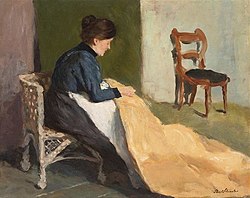Paul Schroeter
Paul Schroeter, or Schröter, (26 October 1866 – 1946), was a German painter and etcher.
Life
Born in Kępno Schroeter initially studied in the early 1880s at the Kunstakademie Düsseldorf, where he was a student of Eduard von Gebhardt, Peter Janssen and Adolf Schill. Here, alongside Fritz Overbeck and other young painters of the academy, he joined the Tartarus student association, which also published irregular magazines in which he participated with illustrations. It was also here that he met the painter Fritz Mackensen, who was already well-known at the time. The painter Peter Philippi described 'Tartarus' as "next to the great Malkasten, [... it] was a [...] refreshing [group or] union of young, seriously aspiring artists, among others Robert Engels, Karl Krumbacher, Ludwig Keller, Otto Modersohn, Robert Weise, Paul Schröter, Adelbert Niemeyer, Ernst Christian Pfannschmidt.[1]
From Düsseldorf, Schroeter moved to the Academy of Fine Arts, Munich and joined the Allgemeine Deutsche Kunstgenossenschaft. Active in Munich since 1893, he became a member of the Munich Secession with participation in the spring exhibition in May 1894.[2] Study trips took him to Holland, Belgium and Spain and for a short time he stayed in the Willingshäuser Malerkolonie, where he met Carl Bantzer, Georg Burmester and Wilhelm Thielmann. From 1898 to 1901, Schroeter lived in Hamburg and became friends with Ernst Eitner and Arthur Illies, the co-founders of the Hamburgischer Künstlerklub. As an illustrator, he produced commissioned works for the Munich magazine Jugend: 1898 Haideblume and Dornröschen und die Alte and 1913 a Vignette.[3]
He had a close friendship with Mackensen, Modersohn and Overbeck, and they persuaded him to come to the still young Künstlerkolonie Worpswede. With his wife Grete and their children, Schroeter moved to Worpswede in 1901, and from there to Horn-Lehe around 1904, where he became a member of the Deutscher Künstlerbund.[4] There, in northern Germany, he painted portraits, landscapes and interior pictures with mostly rural themes. The reviews were not always positive, as the magazine Die Kunst wrote in 1903:
Schroeter from Munich, now working in Worpswede, makes a heartfelt effort, but his genre paintings and interiors remain impersonal; only here and there, for example in an interior where a mother sits with her child at the dining table while the green garden looks into the room, does one forget this shortcoming above the honest observation of nature.[5]
In 1908, Schroeter left Bremen, moved to Berlin, was a member of the Verein Berliner Künstler, and lived there in Lichterfelde.[6][7]
Schroeter was a still life, landscape, genre and portrait painter as well as a graphic artist. Many of his works are in private collections. Most of his work were lost during the Second World War.
Work
Paul Schroeter Media
Related pages
References
- ↑ Peter Philippi: Die kleine Stadt und ihre Menschen, Bilder, Erlebnisse, Gedichte, Stuttgart, 1949.
- ↑ Die Frühjahr-Ausstellung der Münchener Secession. In Die Kunst für Alle., Munich May 1894, (Selbstporträt Paul Schröter in seinem Atelier. uni-heidelberg.de).
- ↑ Schröter, Paul, Maler, Zeichner, Illustrator, Bildbeiträger. In Jugend; (jugend-wochenschrift.de Archived 2021-10-22 at the Wayback Machine).
- ↑ DKB-Mitgliederverzeichnis 1906: Schroeter, Paul. 3. Deutsche Kuenstlerbundausstellung 1906. Weimar: Selbstverlag. 1906. p. 55.
- ↑ Von Ausstellungen und Sammlungen – Berlin. Die Kunst. Vol. 7 Freie Kunst. Munich: F. Bruckmann. 1903. p. 840.
- ↑ Berliner Adressbuch
- ↑ Berliner Adressbuch
- ↑ Hermann Muthesius (1900). Zeichenunterricht and "Stillehre". Die Kunst und das schöne Heim – Monatsheft für freie und angewandte Kunst. Vol. 15. Jahrgang. Munich: F. Bruckmann. pp. 487–496, here p. 494.
- ↑ Geschichtenerzähler Graphik – Radierung (1914).
Further reading
- Schroeter, Paul. In Hans Vollmer : Allgemeines Lexikon der Bildenden Künstler von der Antike bis zur Gegenwart. Created by Ulrich Thieme and Felix Becker. Vol. 30: Scheffel–Siemerding. E. A. Seemann, Leipzig 1936.
- Roland Demme: Agitation durch Friedrich Bindewald und sein Vorbild Dr. Otto Böckel gegen die jüdische Bevölkerung in der Wilhelminischen Epoche und ihre Auswirkungen bis heute. University Press, Kassel 2015, ISBN 978-3-86219-932-7.




